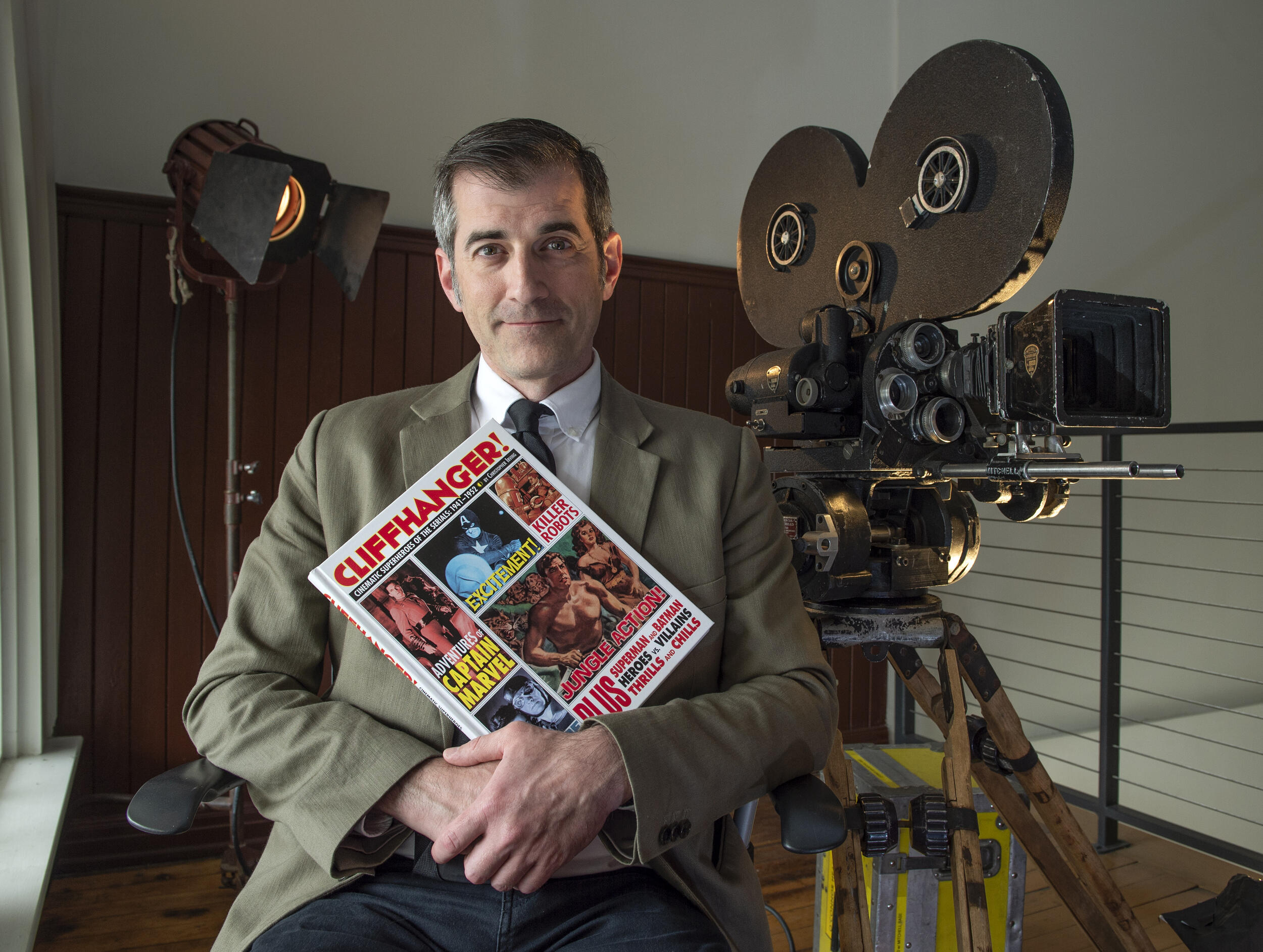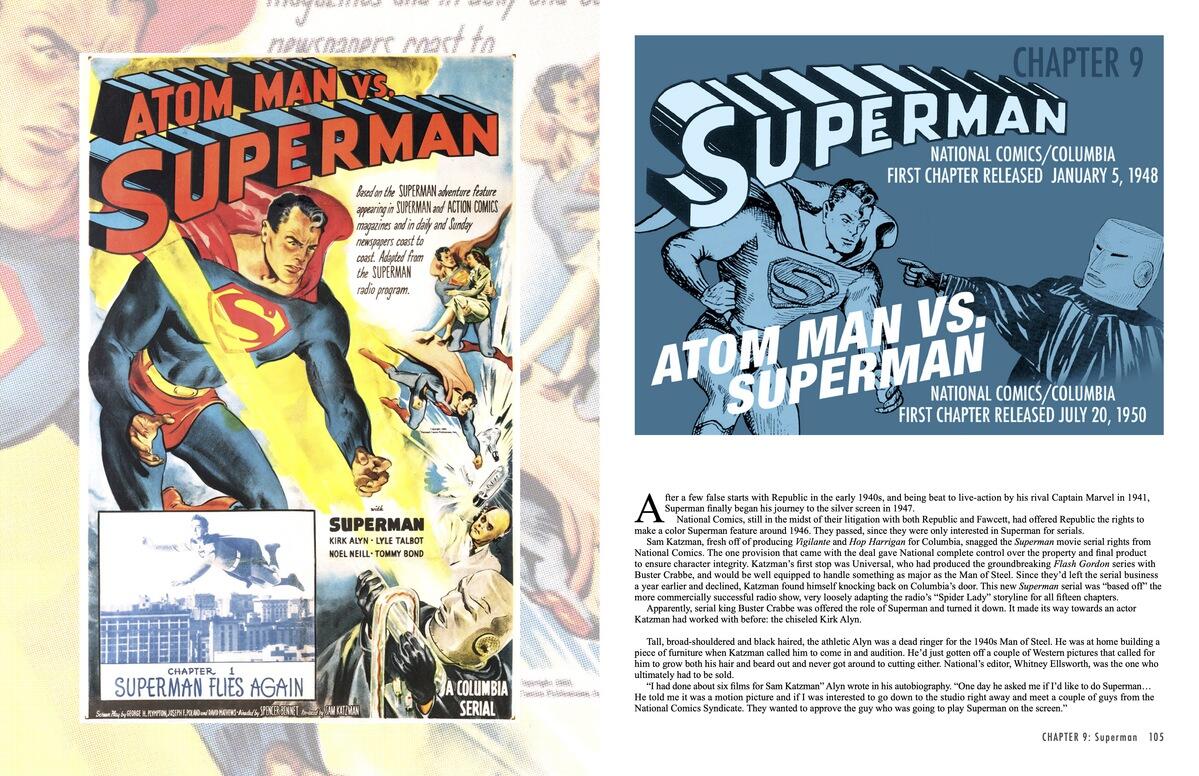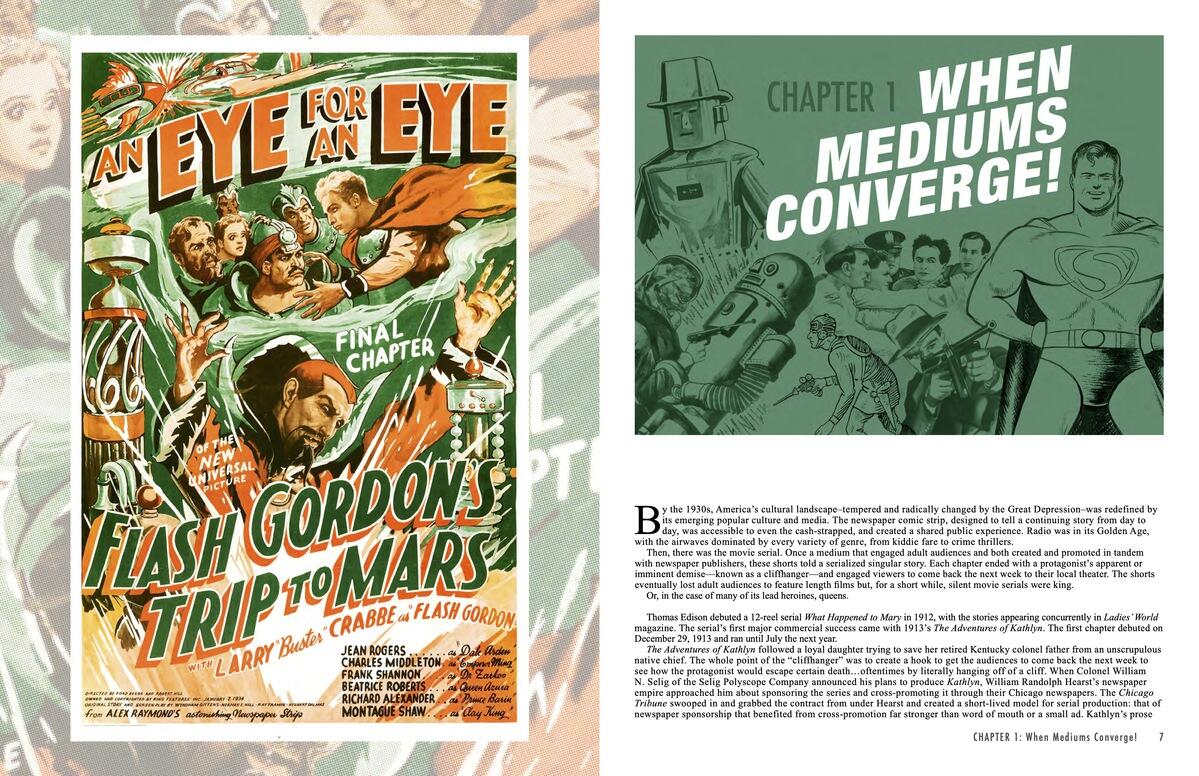
June 5, 2023
Same Bat-Time? Same Bat-Channel? Turns out, superhero cliffhangers came long before the classic 1960s Adam West ‘Batman’ TV series
Share this story
“Cliffhanger!” was … wait for it! … nearly 20 years in the making.
Christopher Irving, an assistant professor of media and visual communications in Virginia Commonwealth University’s School of the Arts, has just released his sixth book on comics history. “Cliffhanger!” is a look at the superhero movie serials of the 1940s, and it extends Irving’s impressive reach in the genre.
His first book, “Blue Beetle Companion,” came out in 2006. While a VCU undergrad in the 1990s, he also worked as a historian and journalist. Since graduating with a degree in art education in 1999, Irving has been a writer, inker, historian and journalist in comics, as well as an actor, screenwriter and extra in TV and film production. In addition to now teaching in VCUarts, he is a doctoral student in the Media, Art and Text program with a focus on the superhero's journey into other media.
“The chance to return to the classroom in communication arts let me marry those interests and pursuit in my teaching,” Irving said. “I knew I wanted a career — rather than just a job — teaching in this specific department when I first set foot in the classroom. I can’t imagine another university with a department that allows students the freedom to explore any and every creative avenue available to them as much as VCU Communication Arts.”
As for “Cliffhanger!” and its long gestation, life got in the way between the first and final drafts. Irving moved to Brooklyn to work on a massive comics journalism project, which turned into “Leaping Tall Buildings: The Origins of American Comics.” He got a master’s degree in comparative literature from Brooklyn College. He moved back to Richmond, gained TV and film experience, and joined VCUarts. And then, most importantly, he became a father. Grayson, now 5, shares his father’s affinity for superheroes and comics.
Yep, Grayson. As in Dick — the first Boy Wonder, one-time Batman, current Nightwing and one of the most loved and respected superheroes in the comics world.

“Looking at it all now, that book marks so much personal and scholarly growth in myself,” Irving said of “Cliffhanger!” “I knew I couldn't be really happy until I got to tell these amazing stories of the people behind the drawing tables and movie cameras.”
Irving has been interested in superheroes and comics for as far back as he can remember: watching “Superman III” on HBO as a 6-year-old in 1983; kicking off comic book collecting with “Batman” #428, which featured the infamous death of the second Robin, Jason Todd, in 1988; witnessing the world of big-screen adaptations forever changed with the release of Tim Burton’s “Batman” in 1989.
Teaching at VCUarts, Irving’s first course was Comic Book History, and he has since taken over the History of Visual Communications lecture course. He also considers himself “super” lucky to get to teach courses on film and comics media, including Superhero Decoded, Batman in Media and two “Star Wars” courses. Much of that is thanks to the encouragement and support of TyRuben Ellingson, director of the Department of Cinema, and Matt Wallin, professor and chair of the Department of Communication Arts, he said.
Irving talked with VCU News about “Cliffhanger!” and the enduring love of comic book heroes.
First, who is your favorite superhero?
Superman. So much that I’m crafting my MATX dissertation on his remediation over the years. To me, Superman is about the nobility and kindness we should all have, without motivation or prodding. He also exemplifies the grace to keep living a fruitful life helping others, even with the loss of his entire race, and living a life as Clark Kent, where he is in a constant state of holding back.
Superman should be bitter, but he isn't, no matter what life has thrown at him. I admire and love him for that.
What is it about superheroes that appeals to both children and adults?
Superheroes are widely adaptable to elements of other genres, which can broaden their appeal, and also represent certain life experiences. You have Greek mythology (Wonder Woman), coming-of-age and survivor’s guilt (Spider-Man), a story of trauma and vengeance (Batman) and being an immigrant (Superman). These are all elements that evolved over time and have made superheroes more than two-dimensional figures on paper.
Superheroes are also creatures of several media, like cartoons, TV and movies. That’s where they have most recently had their appeal to kids, such as in movies like “Super-Pets” or cartoons like “Batman: The Brave and the Bold” (both approved by my 5-year-old, Grayson). The movie serials of the 1940s were chapter plays that ran in movie theaters one a week, each one ending on a cliffhanger to get audiences back, and they were aimed at a kid audience — but that was also in a time when superheroes were meant to cycle through kid readers every few years.
Why did you choose this period to write about in “Cliffhanger!”?
There’s something so endearing and impressive about this first decade of the superhero’s existence — the first credited superhero, Superman, debuted in 1938 — and how quickly this new genre in the young comic book medium got snatched up for film adaptation.
I can't imagine another university with a department that allows students the freedom to explore any and every creative avenue available to them as much as VCU communication arts.
Christopher Irving, an assistant professor of media and visual communications in Virginia Commonwealth University’s School of the Arts
What was the impetus for the book?
I began work in 2006 when I was looking for a next research/book project and realized no one had written about the first movie superheroes in a way that tied both comics and film history together. Also, around 2001, I inherited the movie serial collection — a box of VHS tapes — from the legendary comic book artist Gray Morrow. I had always loved serials when I could find them, but this opened up an entire new world to me.
He had some phenomenal serials, including “Flash Gordon” and “Dick Tracy,” as well as “Zorro’s Fighting Legion.” These were relatively low-budget, done on a tight schedule, and featured stunts by some of the greatest stunt performers in the history of film. As stiffly acted and primitive as the serials can be, they are also just as dynamic in everything from fight scenes to editing.
The book sat on the backburner for a number of years, as I finished a draft for another publisher that didn’t ultimately pan out. I revisited it a few years ago, now with more information at my disposal, as well as my own experiences on set to pull from. The end result focuses on both the comic book and movie serials creators, in what I hope pays homage and ties together the histories of both media.
Who was the first on-screen superhero? How did that come about?
The first on-screen superhero was actually Captain Marvel in 1941. Folks today think of him more as Shazam. It’s a pretty fantastic story.
Superman’s publishers were in talks with the movie serial wing of studio Republic Pictures to make a Superman serial. That fell through, mostly because of an agreement National Comics had made with Paramount for the Superman animated cartoons by the Fleischer brothers. So, Republic, which was already early in production on Superman, renamed some characters and hastily reworked the Superman serial as “The Mysterious Doctor Satan.”

They did, however, strike a deal with Fawcett, which published Superman’s biggest competitor, Captain Marvel. The Captain Marvel serial has a novel way of handling the superhero flying: Special-effects whizzes the Lydecker brothers created a balsa wood mannequin that, along with a pulley and cable, would “fly” downward, or could be dropped backward with the film reverse to “fly” upward. This was all intercut with shots of the stunt performer, Davy Sharpe, in costume making one of his flying leaps or acrobatic landings.
Funny thing? The mannequin was repainted and outfitted from the Superman one for that aborted serial. When National Comics sued Fawcett over Captain Marvel's “likeness” to Superman, Republic was also sued in the case.
What would you like to add?
Possibly the coolest interview “get” of my career was for this book. Lewis Wilson played Batman in 1943 in the serial that marked his live-action debut. His son, Michael, agreed to an interview for the book. Michael also happens to serve as a long-running co-producer on the James Bond films.
Most importantly, though, I dedicated this book to the memory of Gray Morrow. There's no way it could have happened without his crazy serial collection in the first place.
If anyone wants to really learn about the superhero’s trajectory in film, and how it set the stage for the cinematic universe viewing habits of Marvel, this book is written for you.
Subscribe to VCU News
Subscribe to VCU News at newsletter.vcu.edu and receive a selection of stories, videos, photos, news clips and event listings in your inbox.







